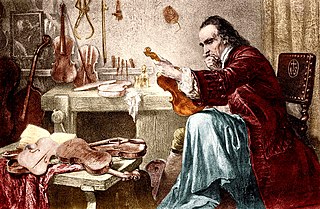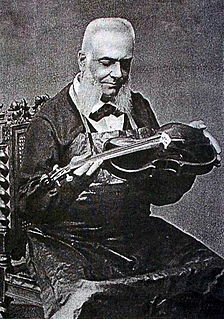Amati is the last name of a family of Italian violin makers who lived at Cremona from about 1538 to 1740. Their importance is considered equal to those of the Bergonzi, Guarneri, and Stradivari families. Today, violins created by Nicolò Amati are valued at around $600,000. Because of their age and rarity, Amati instruments are mostly kept in museum or private collections and are seldom played in public.

Antonio Stradivari was an Italian luthier and a craftsman of string instruments such as violins, cellos, guitars, violas and harps. The Latinized form of his surname, Stradivarius, as well as the colloquial Strad are terms often used to refer to his instruments. It is estimated that Stradivari produced 1,116 instruments, of which 960 were violins. Around 650 instruments survived, including 450 to 512 violins.
A luthier is a craftsperson who builds and repairs string instruments that have a neck and a sound box. The word "luthier" is originally French and comes from the French word for lute. The term was originally used for makers of lutes, but it came to be used already in French for makers of most bowed and plucked stringed instruments such as members of the violin family and guitars. Luthiers, however, do not make harps or pianos; these require different skills and construction methods because their strings are secured to a frame.

Charles Jean Baptiste Collin-Mezin (1841–1923) was a French maker of violins, violas, cellos, basses and bows. He was an Officier de l'Académie des Beaux-Arts and won gold and silver medals at the Paris Exhibitions in 1878, 1889, and 1900.

Jean-Baptiste Vuillaume was a French luthier, businessman, inventor and winner of many awards. His workshop made over 3,000 instruments.

Carlo Bergonzi was an Italian luthier and is the first and most noted member of the Bergonzi family, an illustrious group of luthiers from Cremona, Italy, a city with a rich tradition of stringed instrument makers. Today his instruments are highly valued for their workmanship and tone. Although he was historically assumed to have first apprenticed with Hieronymus Amati or Antonio Stradivari, he is now known to have been the student of Vincenzo Rugeri.

Bartolomeo Giuseppe "del Gesù" Guarneri was an Italian luthier from the Guarneri family of Cremona. He rivals Antonio Stradivari (1644–1737) with regard to the respect and reverence accorded his instruments, and for many prominent players and collectors his instruments are the most coveted of all. Instruments made by Guarneri are often referred to as Del Gesùs.

Gagliano is the name of a famous family of Italian luthiers from Naples, dating back to the early 18th century. The Gagliano dynasty - particularly Alessandro, Nicolò I and Gennaro - are considered the high point of Neapolitan violin making. There are as many as eighteen Gagliano violin makers known worldwide today. Below is a family tree of a few of its most recognizable luthiers.

Matteo Goffriller (1659–1742) was a Venetian luthier, particularly noted for the quality of his cellos. He was active between 1685–1735 and was he founder of the "Venetian School" of luthiers, during a time when Venice was one of the most important centers of musical activity in the world.
Samuel Zygmuntowicz is an award-winning contemporary luthier. He began his instrument making training at age 13, and studied making and restoration under Peter Prier, Carl Becker and René Morel. Since 1985 he has been based in Brooklyn, New York. His early work demonstrates expert skill as a copyist of classic instruments. Later work includes personal models informed by intensive advanced research. Findings from this research have been published in numerous print and digital media. Zygmuntowicz is an active fiddler, playing with several folk music groups. His playing can be heard on the recordings Grand Picnic, and Jump When the Trumpets Blow.

Ernst Heinrich Roth (1877–1948), also often referred to as Ernst Heinrich Roth I to distinguish him from later family members of the same name, was a German luthier and master of a large and successful violin-making workshop in the East German town of Markneukirchen, near the current border with the Czech Republic. He was the most important and distinguished figure in a whole dynasty of Roth luthiers active in Germany over many generations and to this day.

Ansaldo Poggi was born in Villafontana di Medicina (Bologna), 9 June 1893 and died in Bologna, 4 September 1984. He demonstrated his talent for the making of stringed instruments at a young age. His father, also an artisan, musician and amateur violinmaker, encouraged his son, steering him toward the arts. After the end of World War I he dedicated himself to the profession, taking up the craft again alongside his father while at the same time graduating from the Philharmonic Academy of Bologna. In 1921 he met up with the famous luthier Giuseppe Fiorini, of whom he was an adored disciple. In 1923 he won his first silver medal with a viola at the National Competition in Rome.

Paolo De Barbieri was an Italian violin maker. Trained in Cesare Candi's workshop, Paolo DeBarbieri is now considered one of the best violin makers of the school of Genova. His style changes greatly during the years, but it is always easy recognisable for his unmistakable making technique, based on the 'continuous' linings. His workmanship is fine and inspired, and reveal very good taste and good technique.

Nicolas Lupot was one of the most illustrious French luthiers of his time.
Arthur Edward Smith, known as A. E. Smith, was an English-born Australian violin and viola maker whose violins and violas are prized for their 'excellence of tone' and 'decorative elements'. According to some musicians, "it is his violas that have the greatest reputation, being easily counted amongst the greatest ever created, regardless of era or nationality."

Thomas Meuwissen is a Belgian violinmaker. Since 1987 he has been working exclusively on the production of modern and baroque violins, violas and cellos. His work includes antiqued copies of instruments by old Italian masters. His many years of experience as violin maker, enable him to make effective adjustments to the sound of clients’ instruments.
Marino Capicchioni was an Italian musical instrument maker.

The Violin Museum is a musical instrument museum located in Cremona. The museum is best known for its collection of stringed instruments that includes violins, violas, cellos and double basses crafted by renowned luthiers, including Antonio Stradivari and Giuseppe Guarneri del Gesù.

Vincenzo Rugeri, was an Italian luthier of string instruments such as violins, cellos, and, violas in Cremona, Italy. His instruments are noted for their craftsmanship and tone quality. Vincenzo came from a distinguished family of luthiers, the first of whom was his father, Francesco Rugeri. Despite the local tradition of artisan families laboring together through generations, Vincenzo left the family shop and set up a successful shop of his own in the center of Cremona. Vincenzo was the third son of luthier Francesco Rugeri. Vincenzo's work, like Francesco's, is influenced by Nicolò Amati's Grand Pattern model, however Vincenzo's work was distinguished from his father's by utilizing a lower arch inspired by Antonio Stradivari. An analysis of the body of his work reveals that the quality of Vincenzo's instruments is remarkable, perhaps even more so than his father's. Vincenzo's instruments, though less numerous, are valued at least equal to those of his father. A violin by Vincenzo Rugeri realized $502,320 on October 3, 2011 at Brompton's Auctions in London. Carlo Bergonzi was a distinguished apprentice of Vincenzo Rugeri.
Richard Tobin was an Irish luthier who crafted violins, violas, cellos and pochettes. He was an exceptionally talented craftsman and was considered the finest scroll carver of his time. Despite his talent, his work was largely uncredited, often branded under the names of his employers and other shops that enlisted him for his sought-after workmanship. Today, his rare instruments command the highest prices of any Irish luthier.










